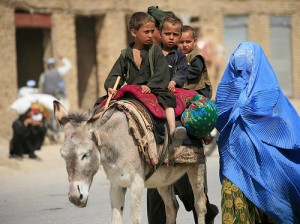Looking for Hope in Afghanistan
Jan 27th, 2012 | By admin | Category: Other ResourcesBy Suzanne York, HowMany.org, January 26, 2012
Most of the news we get about Afghanistan is negative and depressing. This is especially true where womens’ rights and reproductive health are concerned. But if we look hard, there are signs of hope.
First, some cold hard facts. The population of Afghanistan today is 31 million people, and it is expected to more than double by 2050 to 76 million. Forty-four percent of the current population is under age of 15. Afghan women have one of the lowest ages of female life expectancy, at approximately forty-eight years. It is an extremely poor country, where one-third of Afghans live in absolute poverty and a further 37% just above the poverty line, and the government is highly dependent on foreign-assistance.
Despite some positive laws, Afghanistan still ranks as the world’s sixth-worst country for women’s equality in the U.N. Development Program’s annual Gender Inequality Index.
It’s hard to even know where to start in such a war-torn and impoverished nation. A good place to begin is family planning. In the words of New York Times columnist Nicholas Kristof, family planning is a solution to “many of the global problems that confront us, from climate change to poverty to civil wars”. It is also a good investment of U.S. foreign-assistance.
There are even national security experts who understand the import role reproductive health and family planning should play in U.S. and international policy in Afghanistan.
That’s the talk. What’s happening on the ground?
The World Health Organization reported on the work of one group, the Rural Expansion of Afghanistan’s Community-based Health care (REACH) Project, supported by various governments and NGOs. Their efforts produced some interesting results regarding family planning in a Muslim country:
- Traditional rural communities will rapidly accept modern contraceptives, particularly injectables, introduced by community health workers, when people are educated about common non-harmful side-effects and correct use.
- Medical misconceptions were more important than cultural and religious barriers.
- Men’s involvement was vital in supporting their wives’ use of birth spacing. Once educated, men supported positive practices about birth spacing for maternal and child health.
Efforts to improve maternal health have also produced some positive results. A 2011 working paper by the Council on Foreign Relations (CFR) discussed progress made in this area in the face of the reality that Afghan women are more than two hundred times more likely to die during child birth than by a bomb or bullet.
Opportunities for Mother and Infant Development (OMID, an acronym that means “hope” in Dari) is an urban community-based maternal and child health project. OMID works with family and community decision-makers – namely mothers-in-law, husbands, mullahs, and community elders – to educate them on the importance of appropriate healthcare for women and children.
According to the CFR report, OMID has established forty-five (43 women’s and two men’s) community support shuras (councils) in Kabul to educate family decision-makers about the importance of maternal health and family planning. Men who have participated in these community support shuras said that they now understand why maternal health and family planning are “more than just women’s issues.”
Given the low status and repression of Afghan women, any successful outcome will need to include a strong women’s empowerment and rights component and incorporate a holistic approach – family planning, healthcare, girls education, strengthening of economic and political opportunities, and positive involvement/counseling of men. A focus on youth is also critical, given the high percentage of young Afghans.
There are obviously many obstacles and difficulties to overcome in Afghanistan. But it helps to know that there are signs of success on issues important to women that can provide a ray of hope.
Suzanne York is a writer with the Institute for Population Studies/HowMany.org

